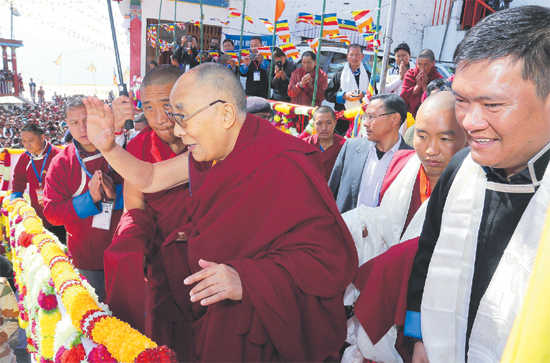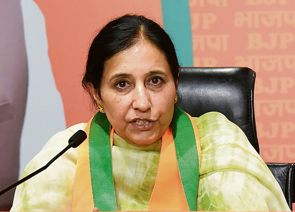
Fall guy: China fears that the next Dalai Lama may be born in Tawang.
G Parthasarathy
THE recent visit of the Dalai Lama to Arunachal Pradesh produced a hysterical reaction from China. The foreign office officially protested against the visit. China’s foreign policy mouthpiece, The Global Times, went ballistic, threatening India with dire consequences and asserting that India should remember that it is substantially weaker than China, both economically and militarily. Lecturing and criticising India on a number of foreign policy issues accompanied this. The ‘Middle Kingdom’ evidently feels emboldened to adopt such pressures, after it has succeeded in annexing territories across its maritime borders, using coercive diplomatic, economic and military pressures. China has embarked on a determined quest for hegemony, beyond its land and maritime borders.
The Chinese termed the visit of the Dalai Lama, particularly to the monastery town of Tawang, as a ‘provocation’. This, despite the fact, that it was his sixth visit to Tawang. The Tawang monastery was founded in 1681, with the blessings of the Fifth Dalai Lama. It assumes a special place in Tibetan hearts and minds, as the Sixth Dalai Lama was born in Tawang. China has ruthlessly coerced the Buddhist clergy and people in Tibet into virtual submission. Its remaining fear is that circumstances may arise, in which the next Dalai Lama is born in Tawang. The spiritual independence and heritage of the persecuted Tibetans would then remain linked with India.
The McMahon Line was declared as the border between India and Tibet under a tripartite accord signed in 1914. Tawang was on the Indian side of this line. China repudiated this accord. But, following Independence, India took control of Tawang in 1951. China, in turn, laid claim to large parts of Arunachal Pradesh, well beyond the borders defined in 1914. Beijing asserted that it never recognised the McMahon Line. With rhetoric over the border escalating, PM Chou Enlai stated in 1956 that while China never recognised the McMahon Line, the line was an ‘accomplished fact’. He added that China should ‘recognise this line’. In April 1960, Premier Chou offered to ‘accommodate’ the Indian point of view on the eastern sector if India agreed to address China’s concerns on the ‘western sector’ across the Ladakh-Tibet border, where China had constructed a vital strategic road linking Buddhist-dominated Tibet to the Muslim-dominated Xinjiang region.
India’s borders with China in the western Tibet-Ladakh sector have changed through the 19th century. The stalemate following the Dogra incursion into Tibet, led by Gen Zorawar Singh in 1841-1842, and the subsequent takeover of Ladakh by the British resulted in the Johnson Line, drawn by the British in 1865, becoming the border with Tibet. Xinjiang was then not a part of China. The borders drawn in the Johnson Line included large parts of Aksai China, linking Tibet and Xinjiang. When geopolitical circumstances changed, the British drew the border with China along a new MaCartney-Macdonald Line, which enabled Chinese access to Xinjiang. This line, offered in 1899, was informally accepted by China. It leaves the strategic Karakoram Pass under India’s control. What Chou Enlai offered prior to the 1962 conflict was acceptance of the McMahon Line in the east in return for India’s acceptance of the MaCartney-Macdonald Line. This was a proposal that many believe PM Nehru would have been well advised to accept. Chinese claims were, however, refuted. India was drawn into a conflict for which the country was ill-prepared militarily and psychologically, thanks to the earlier Hindi-Chini bhai bhai sloganeering.
China now believes that the asymmetry in the military, economic and technological power between India and itself is so great that it need not pay even lip service, or adhere to Chou Enlai’s proposals, which were reiterated by Deng Xiaoping Xiaoping in 1979. China now expects that India will have to make serious territorial concessions in Arunachal Pradesh (at the very least handing over Tawang and some other strategic areas) in return for anything closely corresponding to the 1899 proposals in the Ladakh sector. It is for this reason that Beijing has refused to even spell out the positions where the ‘Line of Actual Control’ arising from the 1962 conflict lie. One can expect no change in this position in the foreseeable future. The main reference points that India can use to bolster its case lie in the very well-negotiated April 2005 agreement on the ‘Political Parameters and Guiding Principles for Settlement of the India-China Boundary Question’.
Article VI of the 2005 agreement states that the boundary should be ‘along well-defined and easily identifiable natural geographical features, to be mutually agreed upon between the two sides’. Article VII states: ‘In reaching a boundary settlement, the two sides shall safeguard due interests of their settled populations in the border areas’. Both these articles render Chinese claims on Tawang and indeed on areas on the Indian side of the McMahon Line in Arunachal Pradesh largely untenable. But China is not going to be influenced by words alone. The border dialogue between the two countries thus has presently to be focused on strengthening confidence-building measures to maintain peace. But we should never forget that the Chinese are supreme realists and will not hesitate to use military power to their advantage when expedient. New Delhi has been steadily reducing the share of its defence budget. It now is barely 1.6 per cent of GDP. Is India doing enough to ensure that China cannot prevail in any standoff along our borders? This needs much greater attention by our parliamentarians.
It would be foolish to cut our nose to spite our face by seeking to discourage trade and investment ties with China. But we should have no doubt that in its quest for hegemony in Asia, China will give no diplomatic space to countries like Japan, India and Vietnam to enhance their economic influence. This is reason enough for us to avoid seeking membership of the Chinese-dominated Regional Comprehensive Economic Partnership. China’s recent unprecedented abstention in the UN Security Council in the face of an American diplomatic onslaught on Russia, on developments in Syria, shows that Beijing can dump even major allies when it suits its interests. Dealing with a hegemonic China is going to require considerable courage, skill and attention.



























